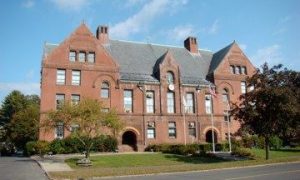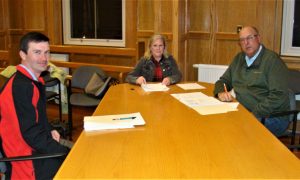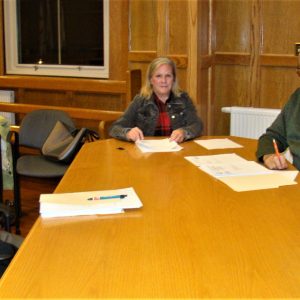WESTFIELD — Taking one more step before the City Council votes to approve financing for the new elementary school, estimated to cost $61 million, the elementary school building committee presented the project to the council at its meeting on Dec. 2.
Mayor Donald F. Humason Jr., who serves as chair of the school building committee, began by praising the committee.
“My term is wrapping up, and the past two years has been very enjoyable. One of the biggest things I’ve enjoyed is the work on bringing the new school to Westfield,” he said, singling out Councilors Ralph J. Figy and Bridget Matthews-Kane, who also served on the committee.
Humason thanked Superintendent Stefan Czaporowski and his team, the city financial team and especially city purchasing agent Tammy Tefft, who served as vice chair of the committee. He also gave a special thank-you to owner’s project manager Daniel Pallotta of P3 Project Planning Professionals Inc. and architect Bert Gardner of Caolo & Bieniek Associates of Chicopee.
“Thank you again for allowing me to work on it,” Humason said
“I echo what Mayor Humason said. In terms of professional growth, it was fantastic,” said Czaporowski. He called it a very collaborative effort, with “many, many, many hours on Zoom.” He also said staying on task during the pandemic was “a huge feat.”
Gardner then presented the project to the council. He said after an exhaustive feasibility study, the best choice for Westfield was to combine the student bodies of Abner Gibbs Elementary School, which is 105 years old, and Franklin Avenue Elementary School, 68 years old, at one new structure. He said both schools will be missed, but they lack the infrastructure of a new school and the flexibility in the classroom needed for changes in teaching.
The planned school is a two-story building, oriented towards Franklin Street (Route 20), which opens up the whole north half of the site — the current site of Franklin Avenue Elementary School — to green space. Gardner said a traffic study shows that Franklin Street has the capacity to handle the school traffic. The city can use flashing beacons on crosswalks and other visual cues to help to get cars to slow down.
Gardner said the construction of the project will be phased in. During Phase 1, the city will build the new school and parking lots. When that is complete, all students from both schools will be able to move in at the same time, so the students can discover the new school together, a point that was important to the building committee.
During Phase 2, the contractor will take down the existing school and continue construction of the outdoor facilities.
Gardner said the school is also being designed for community use, with a media center off the lobby, a gymnasium, a cafetorium and availability to the stage from the lobby and also from the music and art classrooms, which all have lots of natural daylight and slightly higher ceilings. He said the flexible classroom “neighborhoods” are separated from the lobby and public spaces by security doors which can be locked after hours to prevent public access, and also locked down for security within the building during school hours.
Pallotta spoke about the process with the MSBA, and reasons why the city’s share of the cost has risen. He said the funding by MSBA to build schools comes from 1 cent of the state sales tax. Westfield was invited in and started the process one week before the COVID shutdown.
The design of the building at 88,000 square feet has only 2,200 square feet of ineligible indoor space, only 2.4 percent, and was designed for extremely efficient space utilization. Forty percent of the outdoor space is ineligible for reimbursement, however, because MSBA funding doesn’t cover large sites.
Pallotta said the committee is also outpacing the reimbursement rate of $1,200 per student for furniture, an allowance which hasn’t changed in eight years, though they have stayed within the $1,200 per student cap for technology.
The main difference between Westfield’s 73.28 reimbursement rate, and the grant of $31 million that the MSBA voted on in October for the $61 million project, is that current construction costs average $569 per square foot, but the cap on the MSBA reimbursement for construction is $364 per square foot, which he said was just increased from $333 per square foot. The difference in construction reimbursement is $18 million.
At-large Councilor James Adams said he had never seen 50 percent reimbursement before, and asked if that is the direction that the state is going in the future.
Pallotta said construction costs are rising faster than the MSBA can reimburse.
“When we started this two years ago, if you told me the cost would be $569 per square foot, I would have told you to get another project manager,” he said.
Adams asked what it would have cost the city without COVID-19. Pallotta said the ineligible costs would have been a lot lower, stressing that the majority of ineligible costs come from the square footage reimbursement . He also said some other trades are paying more than the eligible wage; it’s not just in construction.
At-large Councilor Dan Allie said a lot of the increases are COVID-related, and asked if there is any movement by the state to close the gap.
“I don’t know of any way that we’ll get additional funds from MSBA at this point in time. They have never gone back to a project and added money since they began. They’re giving you $31 million to build a new school. I wish I could say it’s going to go better, but I can’t say that it has,” Pallotta said.
Addressing the timetable, Pallotta said they are looking at Phase 1, construction of the new school and parking area, to be completed in April of 2024, and that he would assume the demolition of the Franklin Avenue building would begin when the school gets out for the year.
“I don’t see a disruption for the children,” he said.
Pallotta said the construction would be done during the school year, next to the old school. He did not predict any complications from having a construction site next to an active school, and said it could get the children excited about the construction process as a part of the educational plan. Both student bodies would start in the new school in the fall of 2025.
“The last school we did, we didn’t lose one hour of education time, [even though] it will be noisy and disruptive,” Pallotta said.
Gardner added that the contractors who will be building the school are “big ones that build schools. They’ll know things like working around testing times. There’s a lot of coordination involved,” he said.
A first vote by the council to approve the financing for the new school is expected to take place on Dec. 16, with the second and final vote on Jan. 6, 2022.


